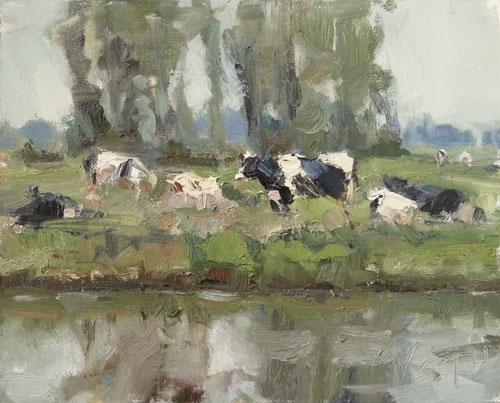 |
| “Cows, Water and Trees.” Original painting by the amazing Roos Schuring. |
Organic gardeners love manure; yet if you use it wrong, you may destroy all you’ve worked for. Bad manure is really, really bad.
I recently was e-mailed by a regular reader. She wrote:
“Hey David, have you done a post on the different types of manure yet?
The reason I asked is that I’m looking to grow my gardening area
(the size) and was thinking about what type of compost/manures to add. I thought about your post about compost manure can be a concern and also from the ag county may have herbicide. I was also considering mushroomcompost (mushroom farm nearby —) but read about the concerns of how the treat for bugs, etc.
So what did I come up with? Bunny poop! ![]() I found on craigslist two bunny poop suppliers here in — – woot!
I found on craigslist two bunny poop suppliers here in — – woot! ![]()
Very inexpensive, one is $3/50 lb size bag, other $12/50 lb bag
(theirs is dried). Since I’m dumping on the ground as soon as I get
bags, not worried about it being “wet”.
Also, I asked the Ag extension people and they said to not worry
about herbicides in their compost, it’s all gone by the time it’s
available.
Sooooo, with spring around the corner and warm crops needing to go
in – if you haven’t done a manure article yet, you might want to
consider it. I know I spent hours researching this and would have LOVED a simple article explaining all this! LOL Yeah, it’ all about me. :)”
“All about me” or not, it’s a good idea. So let’s do it.
Why Manure?
The earth was designed to be a self-perpetuating system; many animals
feed off plants… which in turn feed off animals, both on their manure
and eventually on their bodies when they die.
As animals graze, they pick up plenty of nutrients and what they
can’t use during the course of the day gets excreted. Both urine and
manure are good for gardening but if you’ve ever tried to get a goat to
pee into a mayonnaise jar, you know why farmers usually just collect
manure for their plots. Using animal droppings for farming also makes
sense because it closes the “nutrient loop” and reincorporates fertility
into the soil, rather than disposing of it off site (city sewer
engineers… I’m looking at you!).
For most of recorded history, man has used manure to nourish his
crops. Unfortunately, that usage fell drastically with the advent of the
tractor and the rise of chemical fertilization. It’s a lot easier to
handle dry granules with perfect NPK ratios than it is to collect and
distribute manure. On a small family farm, where you might have
chickens, goats, a cow or even a horse, using manure is easy… but it’s
not so easy on large farms that are growing monoculture crops without
the use of animals.
Unlike chemical fertilizers, manure contains a broad range of nutrients. It also contains organic matter and a range of microorganisms that improve the tilth of the soil and its biodiversity.
My aunt, the most amazing gardener I know, once told me that she and
my uncle had dropped a load of cow manure on their property and
incorporated it into their gardens as needed. The surprising thing was
that the place where they’d originally piled it up off the trailer
remained green and lush for years after the manure had been used up.
That’s good stuff.
What Manure?
This is where things get a little more complicated. The gardener has a
variety of manures available for his fertilizing arsenal so one must
ask what is the best manure for your garden. Some are usually too “hot”
to use right away, like cow, bat or chicken wastes… others are filled
with weed seed, like horse droppings… and others, like humanure, need to
be handled carefully to avoid contact with pathogens.
The good news: composting fixes everything. If you’re not sure if
manure will be too hot, compost it. Waiting will allow some of the
nitrogen to dissipate and kill off pathogens. A few months is usually
good enough, but if you’re paranoid, two years is the magic number in
for complete safety.
Goat and rabbit manure are super-special because you can apply them
directly to the garden without having to worry about burning your
plants. In fact, the gal who wrote me was lucky to get “bunny poop,”
since that’s one of the highest quality droppings you’ll find anywhere.
Though chicken manure sometimes gets a bad rap for being a garden
killer, I’ve found that side-dressing plants with a dusting of dry
chicken manure works well. Just go light – I went a little nuts one year
and roasted some of my kale. If your plants turn yellow and brown, then
you’re doing it wrong.
For my field corn, I put a couple shovelfuls of chicken manure into
the bottom of a 55 gallon drum, then fill 2/3rds full of water. Every
time I visited my field – about every two weeks or so – I’d stir the
amazing-smelling slop and then fill a couple of cheap watering cans
(with the nozzle roses removed) and walk along the corn rows letting the manure water stream out. This works wonders.
Whatever manure you have access to, chances are there’s a use for it
in your garden… unless… well, you’d better just keep reading.


3 comments
Thanks! Great!
Roos… you're my favorite contemporary impressionist. Love your style. ;)
[…] is to use manure for nitrogen fertilizer, but just be sure you know the source very well, because many manures are laced with herbicides from the animals feeding on pastures or hay that was sprayed with herbicide. These herbicides will […]
Comments are closed.